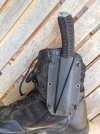- Joined
- Dec 23, 2022
- Messages
- 21
QUESTION: Metal recommendation for a first timer knife maker?
To clarify, I don't have a belt grinder or jig or drill press or the like. I have some Nicholson files, an angle grinder, and my local Ace Hardware. I'm not looking to sell, just have fun fixating my mind on building a knife. I did metal smithing years ago in high school; curious if my hands still have some creation left in them. Carbon vs stainless steel, I'm indifferent towards either. Just looking for something I can easily cut, shape, grind, etc. with hand tools.
Cheers!
To clarify, I don't have a belt grinder or jig or drill press or the like. I have some Nicholson files, an angle grinder, and my local Ace Hardware. I'm not looking to sell, just have fun fixating my mind on building a knife. I did metal smithing years ago in high school; curious if my hands still have some creation left in them. Carbon vs stainless steel, I'm indifferent towards either. Just looking for something I can easily cut, shape, grind, etc. with hand tools.
Cheers!


